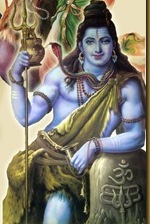A great video presentation, showing the worship in ancient Dravidan Age. The song is again a wonderful composition by Illayaraja on a hymn from Thiruvasagam, a great work by ancient scholar Manichavasagar, sung in praise of Lord Shiva
-- Abirami Varma
For those who want the lyrics ..
பூவார் சென்னி மன்னன்னெம் புயங்கப் பெருமான் | சிறியோமை
ஓவா துள்ளம் கலந்துணர்வாய் உருக்கும் வெள்ளக் கருணையினால் (2)
ஆவா என்னப் பட்டன் பாய் ஆட்பட் டீர்வந் தொருப்படுமின்
போவோங் காலம் வந்ததுகாண் பொய்விட் டுடையான் கழல்புகவே
ஓவா துள்ளம் கலந்துணர்வாய் உருக்கும் வெள்ளக் கருணையினால் (2)
ஆவா என்னப் பட்டன் பாய் ஆட்பட் டீர்வந் தொருப்படுமின்
போவோங் காலம் வந்ததுகாண் பொய்விட் டுடையான் கழல்புகவே
புகவே வேண்டா புலன்களில்நீர் புயங்கப் பெருமான் பூங்கழல்கள் |
மிகவே நினைமின் மிக்க எல்லாம் வேண்டா போக விடுமின்கள் (2)
நகவே ஞாலத் துட்புகுந்து நாயனைய நமையாண்ட |
தகவே யுடையான் தனைச்சாரத் தளரா திருப்பார் தாந்தாமே |
மிகவே நினைமின் மிக்க எல்லாம் வேண்டா போக விடுமின்கள் (2)
நகவே ஞாலத் துட்புகுந்து நாயனைய நமையாண்ட |
தகவே யுடையான் தனைச்சாரத் தளரா திருப்பார் தாந்தாமே |
தாமே தமக்குச் சுற்றமும் தாமே தமக்கு விதிவகையும் |
யாமார் எமதார் பாசம் யார் என்னமாயம் மாயம் இவைபோகக் |
கோமான் பண்டைத் தொண்டரொடும் அவன்தன் குறிப்பே குறிக்கொண்டு |
போமா றமைமின் பொய்நீக்கப் புயங்கன் ஆள்வான் பொன்னடிக்கே |
புயங்கன் ஆள்வான் பொன்னடிக்கே |
யாமார் எமதார் பாசம் யார் என்னமாயம் மாயம் இவைபோகக் |
கோமான் பண்டைத் தொண்டரொடும் அவன்தன் குறிப்பே குறிக்கொண்டு |
போமா றமைமின் பொய்நீக்கப் புயங்கன் ஆள்வான் பொன்னடிக்கே |
புயங்கன் ஆள்வான் பொன்னடிக்கே |
அடியார் ஆனீர் எல்லீரும் அகல விடுமின் விளையாட்டை |
கடிசே ரடியே வந்தடைந்து கடைக்கொண் டிருமின் திருக்குறிப்பை |
செடிசே ருடலை செலநீக்கிச் | சிவலோகத்தே நமைவைப்பான் |
பொடிசேர் மேளிப் புயங்கன்தன் பூவார் கழற்கே புகவிடுமே |
கடிசே ரடியே வந்தடைந்து கடைக்கொண் டிருமின் திருக்குறிப்பை |
செடிசே ருடலை செலநீக்கிச் | சிவலோகத்தே நமைவைப்பான் |
பொடிசேர் மேளிப் புயங்கன்தன் பூவார் கழற்கே புகவிடுமே |
விடுமின் வெகுளி வேட்கைநோய் மிகவோர் காலம் இனியில்லை |
உடையான் அடிக்கீழ்ப் பெருஞ்சாத்தோடு உடன்போ வதற்கே ஒருப் படுமின் |
அடைவோம் நாம்போய்ச் சிவபுரத்துள் அடியார் கதவ டையாமே |
அடைவோம் நாம்போய்ச் சிவபுரத்துள் அடியார் கதவ டையாமே |
புடைபட்டுருகிப் போற்றுவோம் புயங்கன் ஆள்வான் புகழ்களையே
உடையான் அடிக்கீழ்ப் பெருஞ்சாத்தோடு உடன்போ வதற்கே ஒருப் படுமின் |
அடைவோம் நாம்போய்ச் சிவபுரத்துள் அடியார் கதவ டையாமே |
அடைவோம் நாம்போய்ச் சிவபுரத்துள் அடியார் கதவ டையாமே |
புடைபட்டுருகிப் போற்றுவோம் புயங்கன் ஆள்வான் புகழ்களையே
நிற்பார் நிற்கநில் லாவுலகில் நில்லோம் இனிநாம் செல்வோமே |
பொற்பால் ஒப்பாந் திருமேனிப் புயங்கன் ஆள்வான் பொன்னடிக்கே |
நிற்பீர் எல்லாந் தாழாதே நிற்கும் பரிசே ஒருப்படுமின் |
பிற்பால் நின்று பேழ்கணித்தாற் | பெறுதற் கரியன் பெருமானே
பெறுதற் கரியன் பெருமானே |
பூவார் சென்னி மன்னனெம் புயங்கப் பெருமான் | சிறியோமை பொற்பால் ஒப்பாந் திருமேனிப் புயங்கன் ஆள்வான் பொன்னடிக்கே |
நிற்பீர் எல்லாந் தாழாதே நிற்கும் பரிசே ஒருப்படுமின் |
பிற்பால் நின்று பேழ்கணித்தாற் | பெறுதற் கரியன் பெருமானே
பெறுதற் கரியன் பெருமானே |
ஓவா துள்ளம் கலந்துணர்வாய் | உருக்கும் வெள்ளக் கருணையினால் |
ஆவா என்னப் பட்டன் பாய் ஆட்பட் டீர்வந் தொருப்படுமின் |
போவோங் காலம் வந்ததுகாண் பொய்விட் டுடையான் கழல்புகவே |
போவோங் காலம் வந்ததுகாண் பொய்விட் டுடையான் கழல்புகவே |
பொய்விட் டுடையான் கழல்புகவே ……
( People who are keen to know the meaning of this song - kindly look for Poovar Senni Mannan - Song of Thiruvasagam )
---- Abirami



















